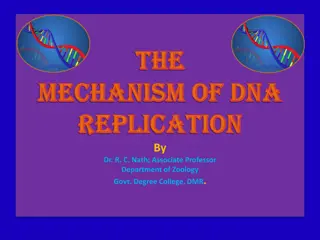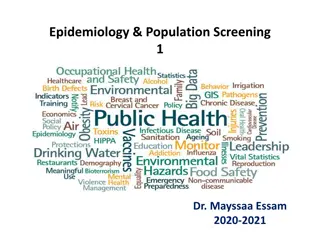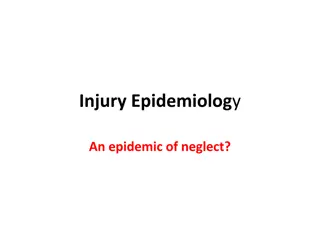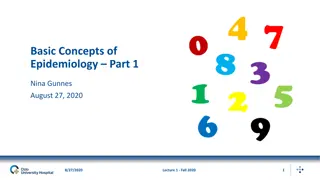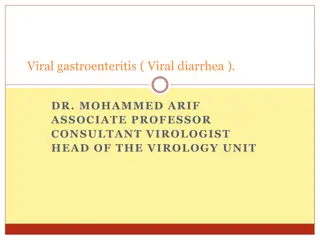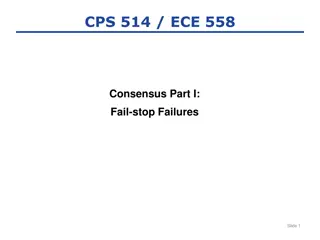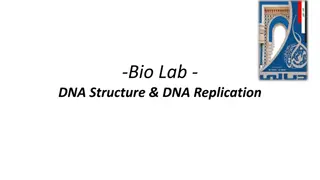Understanding Adenoviruses: Structure, Replication, and Epidemiology
Adenoviruses, known for causing respiratory infections, have at least 41 serotypes categorized into 6 subgenera. Their structure includes 252 capsomeres, 240 hexons, and specific proteins for attachment. The replication involves virus attachment, penetration, uncoating, and transportation of viral DNA to the nucleus for transcription and mRNA production. The genome consists of early and late genes for transcription control and virion structure. Adenoviruses are transmitted through aerosol droplets and fecal-oral route.
Download Presentation

Please find below an Image/Link to download the presentation.
The content on the website is provided AS IS for your information and personal use only. It may not be sold, licensed, or shared on other websites without obtaining consent from the author. Download presentation by click this link. If you encounter any issues during the download, it is possible that the publisher has removed the file from their server.
E N D
Presentation Transcript
DNA Nonenveloped Viruses Lecture Ten Dr.Luma Amer
DNA Nonenveloped Viruses Parvoviruses Adenoviruses Polyomaviruses Papillomaviruses
Adenovirus Structure (animals: more than 100 serotypes, 41 human serotypes)
Adenovirus These viruses are best known for causing upper and lower respiratory tract infections, including pharyngitis and pneumonia. At least 41 serotypes are known classified into 6 subgenera: A to G according to DNA nucleotide sequence
Historical Overview Identified in early 50 s1953. Rowe et al.: removed tonsills or adenoids for tissue culture. Etiologic agent of the Common Cold ? Linear dsDNA encapsidated in protein shell Wild type Adeno used as vaccine in military recruits.
Viruses Structure Icoshedral:252 capsomeres,240 hexons (group spesfic Ag) Penton protein(Toxin) Fiber protein (attachment,HA type spesific Ag) 20 surfaces 12 vertices
Replication : After attachment to the cell surface via its fiber, the virus penetrates and uncoats, and the viral DNA moves to the nucleus. The virus particle has been transported to the nucleus, the core is released and converted to a viral DNA-histone complex. Early transcription is carried out by an RNA polymerase of the host, and a number of primary transcripts are made. The transcripts are spliced, capped, and polyadenylated, giving several different mRNAs.
Adenovirus Genome Late genes E1 E3 E2 E4 36 kb linear ds DNA Early genes for host and viral transcription control, viral DNA replication Late genes for virion structure
Transmission&Epidemiology Adenoviruses are transmitted by several mechanisms: aerosol droplet, fecal oral route, and direct inoculation of conjunctivas by fingers. The fecal oral route is the most common mode of transmission among young children and their families. Many species of animals are infected by strains of adenovirus, but these strains are not pathogenic for humans.
Clinical Syndromes 1. Pharyngitis 1, 2, 3, 5, 7 2. Pharyngoconjunctival fever 3, 7 3. Acute respiratory disease of recruits 4, 7, 14, 21 4. Pneumonia 1, 2, 3, 7 5. Follicular conjunctivitis 3, 4, 11 6. Epidemic keratoconjunctivitis 8, 19, 37 (Shipyard eye) 7. Pertussis-like syndrome 5 8. Acute haemorrhaghic cystitis 11, 21 9. Acute infantile gastroenteritis 40, 41 10. Severe disease in AIDS and other immunocompromized patients 5, 34, 35 11. Meningitis 3, 7
ENTERIC INFECTIONS: second in causative agents causing gastroenteritis in infants (AV types 40, 41,the first one is rotavirus) Urinary tract infections: acute haemorrhagic cystitis: types 11, 21 (children,young adults) INFECTIONS IN IMMUNO-COMPROMISED PATIENTS: encephalitis,pneumonia, gastroenteritis, generalized disease (type 5 and new serotype 34,35)
Pathogenesis & Immunity Adenoviruses infect the mucosal epithelium of several organs, e.g., the respiratory tract (both upper and lower), the gastrointestinal tract, and the conjunctivas. Immunity based on neutralizing antibody is type- specific and lifelong. In addition to acute infection leading to death of the cells, adenoviruses cause a latent infection, particularly in the adenoidal and tonsillar tissues of the throat.
Clinical Findings In the upper respiratory tract, adenoviruses cause such infections as pharyngitis, pharyngoconjunctival fever, and acute respiratory disease, characterized by fever, sore throat, coryza (runny nose), and conjunctivitis. In the lower respiratory tract, they cause bronchitis and atypical pneumonia. Gastroenteritis with nonbloody diarrhea occurs mainly in children younger than 2 years of age. Most adenovirus infections resolve spontaneously. Approximately half of all adenovirus infections are asymptomatic.
Laboratory Diagnosis Detection of Antigen - a rapid diagnosis can be made by the detection of adenovirus antigen from nasopharyngeal aspirates and throat washings. Virus Isolation - virus may be readily isolated from nasopharyngeal aspirates, throat swabs, and faeces. cytopathic effect (roundish cells) Serology - a retrospective diagnosis may be made by serology. CFT most widely used. ENTERIC INFECTIONS diagnosis: ELISA or latex agglutination
Treatment There is no specific antiviral therapy.
Prevention live, non attenuated vaccines against serotypes 4, 7, and 21 are available but are used only by the military. Each of the three vaccines is monovalent, i.e., each contains only one serotype. The viruses are administered separately because they interfere with each other when given together. The vaccines are delivered in an enteric-coated capsule, which protects the live virus from inactivation by stomach acid. The virus infects the gastrointestinal tract, where it causes an asymptomatic infection and induces immunity to respiratory disease. This vaccine is not available for civilian use.
Parvoviruses Nonenveloped, ssDNA Small diameter and genome size Causes distemper in cats, enteric disease in dogs, fatal cardiac infection in puppies Few cause infections in humans 20
Human Parvoviruses B19 cause of erythema infectiosum (fifth disease); rash of childhood Children may have fever and rash on cheeks Severe fatal anemia can result if pregnant woman transmits virus to fetus Adeno-associated virus (AAV) is a defective virus; it cannot replicate in host cell without adenovirus 21



